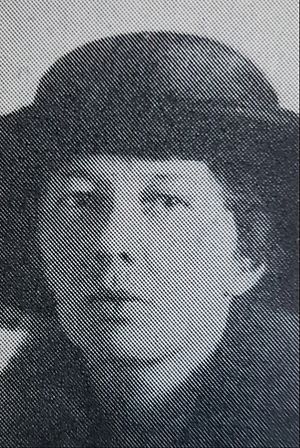Tora Vega Holmström facts for kids
Tora Vega Holmström (born March 2, 1880, in Tottarp, Scania; died January 28, 1967, in Lund) was a talented Swedish painter. She is known for her unique style and the strong feelings her art showed.
Quick facts for kids
Tora Vega Holmström
|
|
|---|---|
 |
|
| Born | March 2, 1880 Tottarp church parish
|
| Died | January 28, 1967 (aged 86) Lunds Allhelgonaförsamling
|
| Occupation | Painter, drawer |
| Parent(s) | Leonard Holmström |
| Family | Malin Holmström-Ingers, Carl Torsten Holmström |
Contents
Early Life and Art Education
Anna Tora Vega Elisabeth Holmström grew up with five brothers and sisters. Her parents ran Hvilan Community College in Åkarp. This was Sweden's very first community college. It was a lively place where people discussed many ideas about society. This environment helped Tora Vega grow her mind and interests.
From 1900 to 1902, Tora Vega studied art at the Valand Academy in Gothenburg. She got into the school because her sister sent some of Tora Vega's drawings to Carl Wilhelmson. He was a famous artist and the director of the painting school. Even though he saw her talent, it was harder for women to become professional artists back then.
Becoming a Professional Artist
Tora Vega Holmström traveled a lot to find inspiration for her art. She visited countries like France, Finland, England, the Netherlands, Belgium, and Algeria. In France, at the Old Port of Marseille, she met a woman named Cathérine who became one of her favorite models.
During her studies, Tora Vega became good friends with two other Swedish artists, Adelheid von Schmiterlöw and Hanna Borrie. They called themselves the "Trois Mousquetaires" (Three Musketeers). They created a special group for women artists and even took a long trip to Paris together in 1907. Tora Vega also worked closely with other artists like Ester Almqvist, Ellen Trotzig, and María Blanchard.
What Tora Vega Painted
Holmström is famous for painting different kinds of art. She created beautiful portraits of people, peaceful still lifes (paintings of objects), and lovely landscapes of Scania. In the 1910s, she found a special theme that became very important in her work: the Scanian peasant woman. Her brother's mother-in-law was the first model for this theme, and Tora Vega loved her proud look.
Tora Vega mainly used oil paint and pastels in her art. At first, her paintings showed a style called romantic nationalism. Later, her art changed and was influenced by modernism from the early 1900s. You can see hints of cubist, expressive, and sometimes even surrealist ideas in her brushstrokes.
A very important moment for her was meeting the color expert Adolf Hölzel in Dachau. This meeting helped her understand colors and contrasts in a more scientific way.
Facing Criticism
In 1914, Tora Vega Holmström showed about a dozen of her paintings at the Baltic Exhibition in Malmö. Her style was strong, and her colors were bold. Some art critics thought her work was too "brutal" and "not feminine enough." But Tora Vega continued to paint in her own unique way.
Meeting Rainer Maria Rilke
Tora Vega also met the famous poet Rainer Maria Rilke. This happened because Hanna Larsdotter invited artists and writers to her castle. Tora Vega and Rilke wrote many letters to each other for several years. Rilke's letters show that they had short meetings and talked about Goethe and color theory.
Tora Vega Holmström never married or had children. This allowed her to focus completely on her art and be a professional artist throughout her life.
Selected Works
- Étrangers (Strangers), 1913-14, Moderna Museet
- Le cavalier (The Rider), 1921, Moderna Museet
- María Blanchard, 1921, Moderna Museet
- Madone espagnole (Spanish Madonna), 1931, Moderna Museet
- Cilia, la tisserande (Cilia, the Weaver), 1937, Moderna Museet

